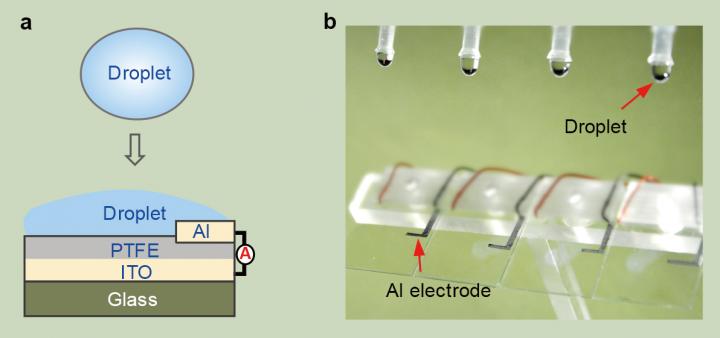Generating electricity from raindrops efficiently has gone one step further. A research team led by scientists from the City University of Hong Kong (CityU) has recently developed a droplet-based energy generator (DEG), featured with a field-effect transistor (FET)-like structure that allows for high energy-conversion efficiency and instantaneous power density increased by thousands times compared to its counterparts without FET-like structure. This would help to advance scientific research of water energy generation and tackle the energy crisis.
The research was led together by Professor Wang Zuankai from CityU’s Department of Mechanical Engineering, Professor Zeng Xiao Cheng from University of Nebraska-Lincoln, and Professor Wang Zhong Lin, Founding Director and Chief Scientist from Beijing Institute of Nanoenergy and Nanosystems of Chinese Academy of Sciences. Their findings were published in the latest issue of the highly prestigious scientific journal Nature, titled “A droplet-based electricity generator with high instantaneous power density”.

Efficiency of electrical energy conversion greatly improved
Hydropower is nothing new. About 70% of the earth’s surface is covered by water. Yet low-frequency kinetic energy contained in waves, tides, and even raindrops are not efficiently converted into electrical energy due to limitations in current technology. For example, a conventional droplet energy generator based on the triboelectric effect can generate electricity induced by contact electrification and electrostatic induction when a droplet hits a surface. However, the amount of charges generated on the surface is limited by the interfacial effect, and as a result, the energy conversion efficiency is quite low.
[ad_336]
In order to improve the conversion efficiency, the research team has spent two years developing the DEG. Its instantaneous power density can reach up to 50.1 W/m2, thousands times higher than other similar devices without the use of FET-like design. And the energy conversion efficiency is markedly higher.
Professor Wang from CityU pointed out that there are two crucial factors for the invention. First, the team found that the continuous droplets impinging on PTFE, an electret material with a quasi-permanent electric charge, provides a new route for the accumulation and storage of high-density surface charges. They found that when water droplets continuously hit the surface of PTFE, the surface charges generated will accumulate and gradually reach a saturation. This new discovery helped to overcome the bottleneck of low charge density encountered in previous work.
Unique field-effect transistor-like structure
Another key feature of their design is a unique set of structures similar to a FET, which is a Nobel Prize in Physics winning innovation in 1956 and has become the basic building block of modern electronic devices nowadays. The device consists of an aluminium electrode, and an indium tin oxide (ITO) electrode with a film of PTFE deposited on it. The PTFE/ITO electrode is responsible for the charge generation, storage, and induction. When a falling water droplet hits and spreads on the PTFE/ITO surface, it naturally “bridges” the aluminium electrode and the PTFE/ITO electrode, translating the original system into a closed-loop electric circuit.
[rand_post]
With this special design, a high density of surface charges can be accumulated on the PTFE through continuous droplet impinging. Meanwhile, when the spreading water connects the two electrodes, all the stored charges on the PTFE can be fully released for the generation of electric current. As a result, both the instantaneous power density and energy conversion efficiency are much higher.
“Our research shows that a drop of 100 microlitres (1 microlitre = one-millionth litre) of water released from a height of 15 cm can generate a voltage of over 140V. And the power generated can light up 100 small LED light bulbs,” said Professor Wang.
He added that the increase in instantaneous power density does not result from additional energy, but from the conversion of kinetic energy of water itself.
“The kinetic energy entailed in falling water is due to gravity and can be regarded as free and renewable. It should be better utilized.”
Their research also shows that the reduction in relative humidity does not affect the efficiency of power generation. Also, both rainwater and seawater can be used to generate electricity.
Facilitates the sustainability of the world
Professor Wang hoped that the outcome of this research would help to harvest water energy to respond to the global problem of renewable energy shortage.
“Generating power from raindrops instead of oil and nuclear energy can facilitate the sustainable development of the world,” he added.
He believed that in the long run, the new design could be applied and installed on different surfaces, where liquid in contact with solid, to fully utilize the low-frequency kinetic energy in water. This can range from the hull surface of ferry, coastline, to the surface of umbrellas or even inside water bottles.